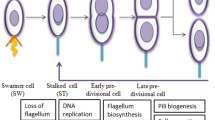
Overview
First comprehensive overview of the alphaproteobacterial cell cycle
A must for scientists studying bacterial cell cycle development
Covers many model species, e.g., Caulobacter crescentus, A. tumefaciens, Brucella
Access this book
Tax calculation will be finalised at checkout
Other ways to access
About this book
This book provides a comprehensive overview of the cell cycle regulation and development in Alphaproteobacteria.
Cell cycle and cellular differentiation are fascinating biological phenomena that are highly regulated in all organisms. In the last decades, many laboratories around the world have been investigating these processes in Alphaproteobacteria. This bacterial class comprises important bacterial species, studied by fundamental and applied research. The complexity of cell cycle regulation and many examples of cellular differentiations in this bacterial group represent the main motives of this book.The book starts with discussing the regulation of cell cycle in alphaproteobacterial species from a system biology perspective. The following chapters specifically focus on the model species Caulobacter crescentus multiple layers of regulation, from transcriptional cascades to proteolysis and dynamic subcellular regulation of cell cycle regulators. In addition, the cell division process, chromosome segregation and growth of the cell envelope is described in detail. The last part of the book covers examples of non-Caulobacter alphaproteobacterial models, such as Agrobacterium tumefaciens, Brucella species and Sinorhizobium meliloti and also discusses possible applications.
This book will be of interest to researchers in microbiology and cell biology labs working on cell cycle regulation and development.
Similar content being viewed by others
Keywords
Table of contents (10 chapters)
-
Front Matter
Editors and Affiliations
About the editor
Emanuele Biondi earned his PhD in Florence (Italy) working on Sinorhizobium meliloti. During his postdoc at Harvard University and then MIT he worked on Caulobacter crescentus cell cycle focusing on signal transduction, discovering how cell cycle controls stalk biogenesis and proposing the first complete regulatory model of Caulobacter cell cycle. In 2010, he joined the French CNRS, and he’s now working in Gif sur Yvette at the Institute for Integrative Biology of the Cell (I2BC).
The Biondi lab has been investigating how cell cycle is regulated in C. crescents and S. meliloti. Using a comparative molecular approach, the Biondi lab aims to elucidate general principles by which bacteria coordinate expression of genes and phosphorylation cascades with asymmetrical cell division and cell differentiation.
Bibliographic Information
Book Title: Cell Cycle Regulation and Development in Alphaproteobacteria
Editors: Emanuele Biondi
DOI: https://doi.org/10.1007/978-3-030-90621-4
Publisher: Springer Cham
eBook Packages: Biomedical and Life Sciences, Biomedical and Life Sciences (R0)
Copyright Information: Springer Nature Switzerland AG 2022
Hardcover ISBN: 978-3-030-90620-7Published: 16 March 2022
Softcover ISBN: 978-3-030-90623-8Published: 16 March 2023
eBook ISBN: 978-3-030-90621-4Published: 14 March 2022
Edition Number: 1
Number of Pages: IX, 301
Number of Illustrations: 5 b/w illustrations, 41 illustrations in colour
Topics: Microbiology, Cell Biology



